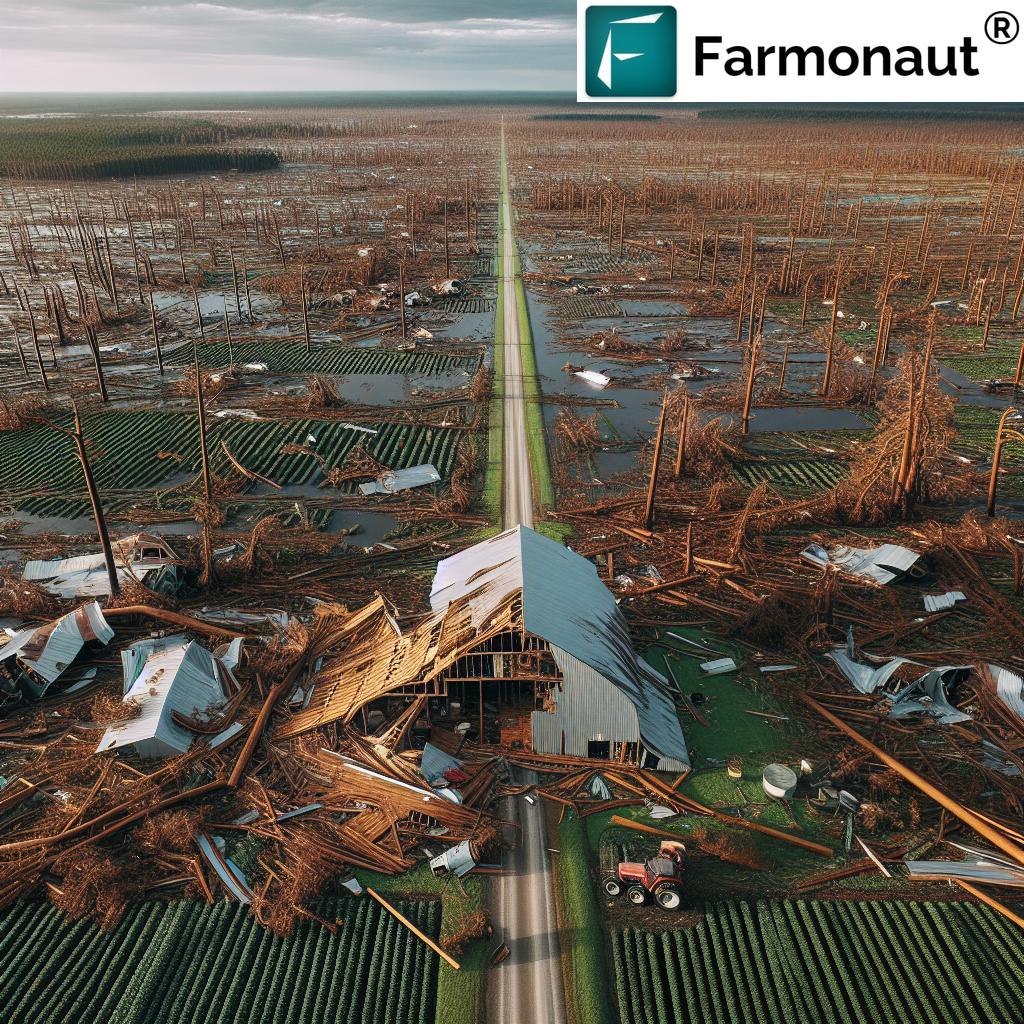Georgia Farmers: Urgent Update on Hurricane Relief and Extended FEMA Deadline for Disaster Assistance
“Hurricane Helene caused an estimated $6 billion in damage to Georgia’s agriculture and forestry industries.”
As we navigate the aftermath of Hurricane Helene in Southeast Georgia, our agricultural community faces unprecedented challenges. The devastating storm has left an indelible mark on our state’s farming landscape, prompting urgent calls for extended federal disaster relief. In this comprehensive update, we’ll explore the extent of the damage, efforts to secure additional funding, and the potential long-term effects on Georgia’s agricultural sector.
The Devastating Impact of Hurricane Helene
Hurricane Helene’s wrath has been felt across 41 counties in Southeast Georgia, causing widespread destruction to our agricultural and forestry industries. The initial estimates paint a grim picture, with damages exceeding $6 billion. This staggering figure doesn’t even account for the additional havoc wreaked on our critical infrastructure, businesses, and homes.
To better understand the scope of this disaster, let’s break down the impact across various sectors:
| Impact Category | Estimated Damage/Effect |
|---|---|
| Total Agricultural Damage ($) | $6+ billion |
| Affected Acreage | Approximately 2 million acres |
| Number of Impacted Farms | Over 10,000 |
| Crop Loss by Type | Cotton: 40%, Peanuts: 30%, Corn: 25% |
| Livestock Impact | Estimated 50,000 head lost |
| Infrastructure Damage | $500 million (irrigation systems, storage facilities) |
| Estimated Recovery Time | 3-5 years |
| Counties Eligible for FEMA Assistance | 41 |
| Projected Long-term Economic Impact | $10-15 billion over 5 years |
These figures underscore the urgent need for comprehensive disaster assistance and highlight the vulnerability of our rural communities to extreme weather events.
Urgent Call for Extended FEMA Deadline
In light of the extensive damage, Georgia state officials are taking decisive action. Speaker Jon Burns (R-Newington) and Georgia Agriculture Commissioner Tyler Harper have jointly appealed to President Donald Trump, urging an extension of the Federal Emergency Management Agency (FEMA) application deadline for affected counties.
This request mirrors similar measures taken in North Carolina, where FEMA deadlines were extended to accommodate the overwhelming need for assistance. The extension is crucial for ensuring that all affected farmers and residents have ample time to navigate the complex application process and secure the help they desperately need.

The Role of Technology in Disaster Recovery
As we grapple with the aftermath of Hurricane Helene, it’s crucial to leverage advanced technologies to aid in recovery and future preparedness. Farmonaut, a leading agricultural technology company, offers innovative solutions that can be particularly valuable in these challenging times.
Farmonaut’s satellite-based farm management solutions provide real-time crop health monitoring, AI-based advisory systems, and resource management tools. These technologies can help farmers assess damage, plan recovery efforts, and make informed decisions about future planting seasons.
- Satellite-Based Crop Health Monitoring: Farmers can use multispectral satellite images to assess the extent of crop damage and monitor recovery progress.
- AI Advisory System: The Jeevn AI system can provide personalized advice on recovery strategies and optimal resource allocation.
- Resource Management: Tools for efficient management of available resources during the recovery phase.
To access these valuable tools, farmers can download the Farmonaut app:
Federal Disaster Relief: Current Status and Future Prospects
The joint letter from Speaker Burns and Commissioner Harper not only requests an extension of the FEMA application deadline but also seeks clarification on when disaster relief funds will be released to the state. This information is crucial for planning and implementing recovery efforts effectively.
President Trump’s administration has historically been supportive of rural America and American agriculture. Commissioner Harper expressed confidence that the administration will deliver the relief that Georgia farm families impacted by Hurricane Helene desperately need.
However, the path to recovery is complex and multifaceted. Let’s explore the various aspects of federal disaster relief and its potential impact on Georgia’s agricultural sector:
1. Immediate Emergency Assistance
- FEMA Individual Assistance: Provides financial help for temporary housing, home repairs, and other disaster-related expenses.
- Small Business Administration (SBA) Disaster Loans: Offers low-interest loans to businesses, nonprofits, homeowners, and renters to repair or replace damaged property.
2. Agricultural Specific Programs
- USDA Emergency Conservation Program (ECP): Helps farmers restore farmlands damaged by natural disasters.
- Livestock Indemnity Program (LIP): Offers payments to eligible producers for livestock deaths in excess of normal mortality caused by adverse weather.
- Emergency Assistance for Livestock, Honeybees, and Farm-Raised Fish Program (ELAP): Provides emergency assistance to eligible producers of livestock, honeybees, and farm-raised fish.
3. Long-Term Recovery Initiatives
- Community Development Block Grant Disaster Recovery (CDBG-DR): Provides flexible grants to help cities, counties, and states recover from presidentially declared disasters.
- USDA Rural Development Disaster Assistance: Offers loans and grants to help rural communities repair or rebuild essential facilities.
The Uncertain Future of Georgia’s Growing Season
“Georgia’s hurricane damage highlights rural America’s vulnerability, with impacts on critical infrastructure and future growing seasons.”
One of the most pressing concerns for Georgia farmers is the uncertainty surrounding future growing seasons. The extensive damage caused by Hurricane Helene has disrupted not only current crops but also the soil, irrigation systems, and overall farm infrastructure necessary for successful future plantings.
Key factors contributing to this uncertainty include:
- Soil Health: Flooding and erosion can significantly alter soil composition and fertility.
- Irrigation Systems: Damaged systems may take months to repair or replace.
- Seed and Input Availability: Supply chain disruptions may affect access to necessary farming inputs.
- Financial Constraints: The cost of recovery may limit farmers’ ability to invest in future crops.
To address these challenges, farmers are turning to innovative solutions. Farmonaut’s technology can play a crucial role in helping farmers assess soil health, plan efficient irrigation, and make data-driven decisions for future plantings.

The Broader Impact on Rural America
The devastation wrought by Hurricane Helene in Georgia serves as a stark reminder of the vulnerability of rural America to extreme weather events. This disaster has far-reaching implications that extend beyond the immediate agricultural losses:
- Economic Ripple Effects: The loss of agricultural production can impact related industries such as food processing, transportation, and retail.
- Rural Infrastructure: Damage to roads, bridges, and utilities can hinder recovery efforts and impact daily life in rural communities.
- Population Displacement: Severe damage to homes and farms may force some residents to relocate temporarily or permanently.
- Mental Health Concerns: The stress of disaster recovery can take a significant toll on the mental health of farmers and rural residents.
Addressing these broader impacts requires a coordinated effort from federal, state, and local authorities, as well as support from the private sector and non-profit organizations.
The Role of Technology in Disaster Preparedness and Recovery
As we look to the future, it’s clear that technology will play an increasingly important role in both disaster preparedness and recovery efforts. Farmonaut’s suite of tools offers valuable capabilities in this regard:
- Predictive Analytics: By analyzing historical weather patterns and current data, farmers can better prepare for potential disasters.
- Real-time Monitoring: Satellite imagery allows for quick assessment of damage and helps prioritize recovery efforts.
- Resource Optimization: AI-driven recommendations can help farmers make the most of limited resources during recovery.
- Data-driven Decision Making: Access to comprehensive data enables farmers and policymakers to make informed decisions about recovery strategies and future planning.
For developers interested in integrating these powerful tools into their own systems, Farmonaut offers an API with comprehensive documentation.
Community Support and Solidarity
In times of crisis, the strength of rural communities often shines through. Across Georgia, we’re seeing numerous examples of neighbors helping neighbors, volunteers stepping up, and communities coming together to support those most affected by Hurricane Helene.
Some notable community efforts include:
- Local food banks organizing special distributions for affected families
- Farmers with less damage offering equipment and labor to help more severely impacted neighbors
- Community fundraising events to support local recovery efforts
- Mental health support groups and hotlines for those struggling with the disaster’s aftermath
These grassroots efforts complement the larger state and federal response, demonstrating the resilience and solidarity of Georgia’s rural communities.
Looking Ahead: Building Resilience in Georgia’s Agricultural Sector
As we work towards recovery, it’s crucial to consider long-term strategies for building resilience in Georgia’s agricultural sector. This disaster presents an opportunity to reassess and improve our approach to farming in a changing climate.
Key areas of focus for building resilience include:
- Diversification of Crops: Planting a variety of crops can help mitigate the risk of total loss from a single disaster.
- Improved Water Management: Implementing advanced irrigation systems and water conservation techniques can help farms better withstand both droughts and floods.
- Soil Health Practices: Adopting techniques like cover cropping and no-till farming can improve soil resilience and water retention.
- Technology Adoption: Embracing precision agriculture tools like those offered by Farmonaut can help farmers make data-driven decisions and optimize resource use.
- Infrastructure Improvements: Investing in more resilient farm structures and equipment can reduce vulnerability to future storms.
The Path Forward: A Call to Action
As we conclude this update on the Hurricane Helene disaster relief efforts in Georgia, it’s clear that the road to recovery will be long and challenging. However, with the combined efforts of our resilient farming community, supportive government initiatives, and innovative technological solutions, we can rebuild and strengthen Georgia’s agricultural sector.
Here are some key actions that various stakeholders can take:
- Farmers: Stay informed about available assistance programs and consider adopting technologies like Farmonaut to aid in recovery and future planning.
- Policymakers: Continue to advocate for timely and comprehensive disaster relief, and consider long-term policies that promote agricultural resilience.
- Community Members: Support local farmers through direct purchases and community initiatives, and volunteer with local relief efforts where possible.
- Agribusinesses: Explore ways to support affected farmers, whether through flexible payment terms, discounted inputs, or technical assistance.
Farmonaut Subscriptions
Frequently Asked Questions (FAQ)
- Q: How long is the current FEMA application deadline for Georgia farmers affected by Hurricane Helene?
A: The exact deadline hasn’t been specified in the provided information. Georgia officials are requesting an extension similar to what was granted in North Carolina. - Q: What types of assistance are available through FEMA for farmers?
A: FEMA offers Individual Assistance, which can include grants for temporary housing, home repairs, and other disaster-related expenses not covered by insurance. - Q: Are there specific USDA programs for farmers affected by Hurricane Helene?
A: Yes, programs like the Emergency Conservation Program (ECP), Livestock Indemnity Program (LIP), and Emergency Assistance for Livestock, Honeybees, and Farm-Raised Fish Program (ELAP) are available to eligible farmers. - Q: How can technology like Farmonaut help in disaster recovery?
A: Farmonaut’s satellite-based crop monitoring and AI advisory systems can help farmers assess damage, plan recovery efforts, and make informed decisions about future plantings. - Q: What steps can farmers take to build resilience against future disasters?
A: Farmers can diversify crops, improve water management, adopt soil health practices, embrace precision agriculture technologies, and invest in resilient infrastructure.
As we face this challenging time together, let’s remain hopeful and committed to rebuilding a stronger, more resilient agricultural sector in Georgia. By leveraging available resources, embracing innovative technologies, and supporting one another, we can overcome the impacts of Hurricane Helene and emerge even stronger.
















